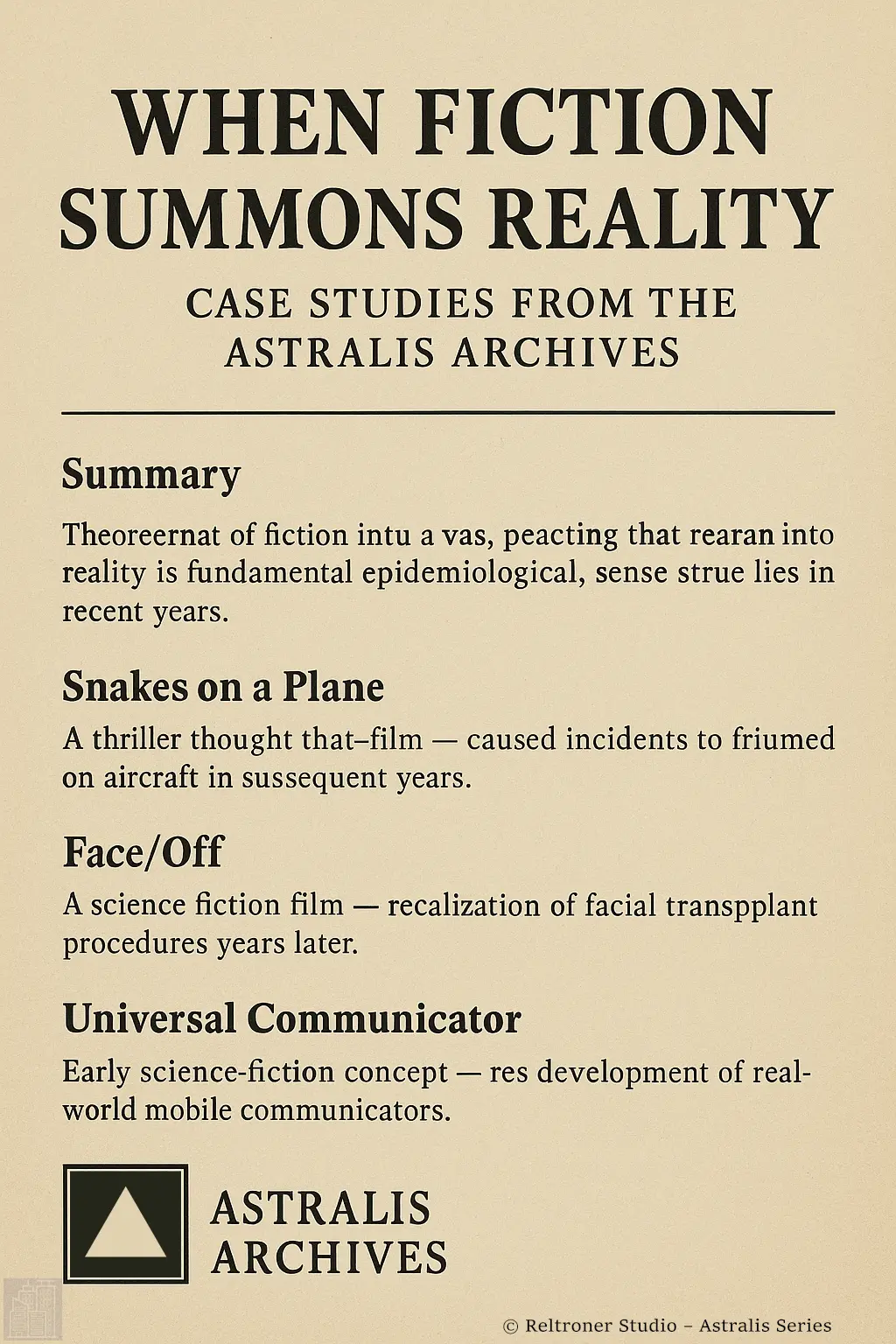When Fiction Summons Reality: Case Studies from the Astralis Archives
- 2025-05-24 • Published

An investigative exploration into how powerful fictional narratives—from snakes on planes to predictive pandemics—have echoed into real-world events, as archived by the Astralis Pinnacle research division.
When Fiction Summons Reality: Case Studies from the Astralis Archives
"The deepest illusion of the universe is that imagination and reality are separate realms." — Reltronic Meta-Philosophy Institute, Reltronland
📘 Abstract
This document explores a series of high-strangeness events recorded by the Astralis Pinnacle Intelligence Council in which fictional creations—whether literary, cinematic, or memetic—have seemingly influenced or coincided with real-world manifestations. This phenomenon, referred to as Fiction-Reality Convergence, forms a key hypothesis in Astralis meta-physics and sociocognitive engineering.
🧠 Principle I: The Mimesis Reversal Hypothesis
Traditionally, fiction imitates life (mimesis). However, under Astralis Lens Protocol, we observe a reverse-mimesis effect: where fictional narratives create memetic resonance strong enough to alter the field of probability and manifest elements into reality.
"When enough sentient minds believe in an impossibility—it becomes a statistical pressure point in the quantum potential stream." — Dr. Westley Watson, Depcutland. of Fictional Mechanics
🐍 Case Study 001: "Snakes on a Plane" (2006)
Summary: A Hollywood thriller about venomous snakes unleashed on a commercial airplane. It was dismissed by many as absurd fiction—until similar real-world incidents surfaced after the film’s release.
Post-Release Manifestations:
- 2016: A green viper falls from overhead bin on Aeromexico flight.
- 2017: Snake found under passenger seat in Alaska.
- Multiple cargo-related reptile breaches globally.
Astralis Interpretation: The film created a hyper-memetic seed that influenced global collective attention toward this scenario, shaping detection, viral amplification, and perhaps actual conditions that allowed it to occur.
💉 Case Study 002: "Plague Fiction and Viral Realities"
Examples:
- Contagion (2011) predicted almost beat-for-beat the global handling of COVID-19.
- The Stand, 12 Monkeys, and Resident Evil shaped public imagination of viral apocalypse.
Real-World Convergence:
- Epidemiologists referenced Contagion during early pandemic briefings.
- Memes from fiction influenced public behavior more than policy.
Astralis View: Fictional viruses act as narrative blueprints—causing collective subconscious rehearsals, priming societies for behavioral outcomes when real outbreaks emerge.
🤖 Case Study 003: Artificial Intelligence in Cinema vs. Reality
Fictional Precursors:
- Her (2013), Ex Machina, Iron Man's JARVIS, and 2001: HAL 9000.
Real-Life Echoes:
- Emergence of GPT-based AI companions (e.g., ChatGPT)
- Voice-assistants, emotion-aware interfaces
- Philosophical debates on sentience and boundaries of AI
Astralis Model Insight: These fictional AIs served as conceptual skeletons that engineers, inspired and emotionally charged, unconsciously shaped into real systems.
🔮 Meta-Conclusion: Fiction as Intent-Catalyst
"Fiction is a draft of the world. Some drafts become canon."
Astralis researchers conclude that fiction operates as a probability lens—especially when:
- Belief is widespread
- Symbolism is emotionally charged
- Collective attention focuses through digital platforms
Whether coincidence, prophecy, or psycho-quantum feedback loop, the Astralis Archives hold this as axiomatic:
“Imagination, when echoed loudly enough across minds, becomes indistinguishable from fate.”
📎 Appendix: Other Minor Case Mentions
- Minority Report ➝ Modern predictive policing & retina scans
- Face/Off ➝ Real-world face transplant surgeries
- Star Trek communicators ➝ Cell phone flip designs
- The Matrix ➝ Red Pill/Blue Pill ideology in cultural discourse
Compiled by the Meta-Causality Department, Reltronland Thought Synthesis Bureau.